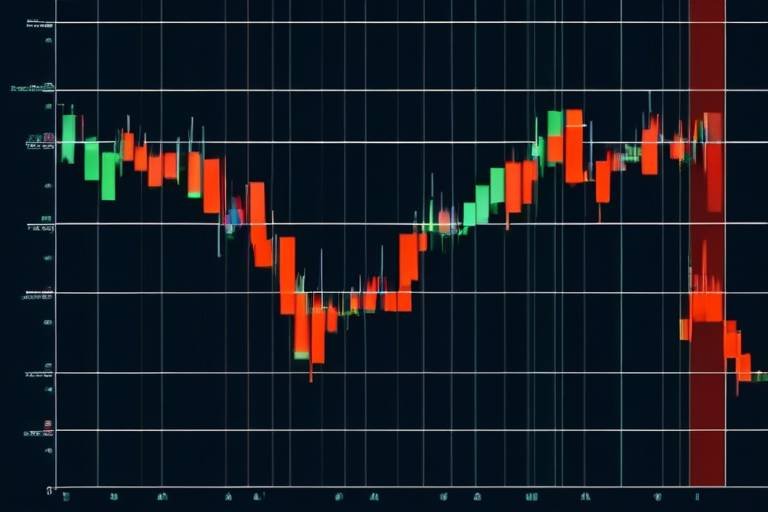How to Use the RSI for Effective Trading
The world of trading can often feel like a rollercoaster ride, full of ups and downs, twists and turns. One tool that can help you navigate this wild ride is the Relative Strength Index (RSI). This powerful momentum oscillator is designed to measure the speed and change of price movements, giving traders a clearer picture of market dynamics. But how do you actually use this tool effectively? In this article, we're diving deep into the RSI, exploring its calculation, interpretation, and how it can be integrated into your trading strategies.
To truly harness the power of the RSI, you first need to understand what it is and how it works. The RSI operates on a scale of 0 to 100, helping traders identify whether an asset is overbought or oversold. Generally, an RSI above 70 indicates that an asset may be overbought, while an RSI below 30 suggests it could be oversold. This simple yet effective indicator can help you make more informed trading decisions, but it’s essential to grasp its underlying mechanics.
Calculating the RSI involves a specific formula that takes into account average gains and losses over a defined period, typically 14 days. The formula is as follows:
RSI 100 - (100 / (1 + RS))
Where RS (Relative Strength) is the average gain of up periods during the specified time frame divided by the average loss of down periods. Understanding how to break down this calculation will empower you to derive accurate RSI values.
Let’s dissect the components of the RSI formula to clarify how the value is derived. The RSI is calculated in two main steps:
- Calculate the Average Gain: Sum the gains over the specified period and divide by the number of periods.
- Calculate the Average Loss: Sum the losses over the specified period and divide by the number of periods.
This breakdown is crucial, as it ensures that you understand how the RSI reacts to price changes, making it easier to interpret its signals effectively.
Average gain and loss are essential elements in the RSI calculation. To compute these averages effectively, you should follow these steps:
- Identify the closing prices for the asset over the chosen time frame.
- Calculate the daily price changes.
- Separate the gains from the losses and compute the averages.
By mastering this process, you'll be able to generate accurate RSI readings that reflect true market conditions.
The choice of time period significantly impacts the RSI's sensitivity. A shorter period will make the RSI more responsive to price changes, while a longer period will smooth out the fluctuations. For example:
| Time Period | Sensitivity |
|---|---|
| 7 Days | High |
| 14 Days | Moderate |
| 28 Days | Low |
Choosing the right time frame is crucial for aligning the RSI with your trading strategy and ensuring that it provides valuable insights.
Interpreting RSI values is vital for making informed trading decisions. When you see an RSI above 70, it often signals that the asset is overbought, suggesting a potential price correction. Conversely, an RSI below 30 indicates oversold conditions, which could present a buying opportunity. However, it’s essential to remember that these signals should not be taken at face value; always consider other market indicators and trends before making a move.
RSI can be integrated into various trading strategies to enhance decision-making. For instance, you can use it to identify potential entry and exit points or to confirm trends indicated by other technical indicators. The key is to combine the RSI with your existing strategies and adapt it to your trading style.
One of the primary uses of RSI is to identify overbought and oversold conditions. Recognizing these signals can help you make timely trade entries. For example, if you notice an RSI reading above 70, it might be a good time to consider selling or shorting the asset. On the flip side, an RSI reading below 30 could indicate a buying opportunity. Always remember to verify these signals with additional analysis.
Combining the RSI with other technical indicators can improve your trading accuracy. For instance, using the RSI alongside moving averages can help confirm trends and provide a clearer picture of market direction. By layering your analysis, you can create a more robust trading strategy that minimizes risk and maximizes potential rewards.
Even experienced traders can make mistakes when using RSI. It’s essential to be aware of common pitfalls to improve your trading outcomes. Let’s explore a couple of these mistakes.
Ignoring the broader market context can lead to misinterpretation of RSI signals. Always consider the overall market trend and economic indicators alongside your RSI analysis. For instance, if the market is in a strong uptrend, an RSI reading above 70 might not be as alarming as it seems. Context is everything in trading!
Overtrading can result from misusing RSI signals. It’s easy to get caught up in the excitement of trading, but maintaining a disciplined approach is crucial. Set clear rules for your trades and stick to them to avoid the pitfalls of impulsive trading decisions.
1. What is the best time frame to use for RSI?
The 14-day period is commonly used, but you can adjust it based on your trading style and preferences.
2. Can RSI be used for long-term trading?
Yes, while RSI is often used for short-term trading, it can also provide valuable insights for long-term strategies when combined with other indicators.
3. How do I avoid false signals from RSI?
Always consider the broader market context and combine RSI with other technical indicators to filter out false signals.

Understanding the RSI
The Relative Strength Index (RSI) is a powerful momentum oscillator that provides traders with insights into the speed and change of price movements. Think of the RSI as a speedometer for a vehicle; it tells you how fast the price is moving and whether it's nearing its limit. By measuring the strength of price action, the RSI helps traders gauge whether a security is overbought or oversold, which can be crucial for making informed trading decisions.
Developed by J. Welles Wilder Jr., the RSI operates on a scale from 0 to 100. Generally, an RSI above 70 indicates that a security may be overbought, while an RSI below 30 suggests it may be oversold. This information is invaluable for traders looking to identify potential reversal points in the market. However, it's essential to remember that these thresholds are not absolute; market conditions can lead to extended periods of overbought or oversold conditions.
The significance of the RSI lies in its ability to provide a visual representation of momentum. For instance, when the RSI is climbing, it suggests that buyers are gaining strength, which could lead to further price increases. On the flip side, a declining RSI may indicate that sellers are taking control, potentially leading to price drops. Thus, understanding the RSI is not just about looking at a number; it's about interpreting what that number means in the context of market dynamics.
Moreover, the RSI can be used in conjunction with other technical indicators to create a more comprehensive trading strategy. For example, combining RSI with moving averages can help confirm trends and identify potential entry or exit points. The beauty of the RSI lies in its versatility; whether you're a day trader or a long-term investor, this tool can be adapted to fit your trading style.
In summary, mastering the RSI is essential for any trader looking to enhance their trading toolkit. By understanding how the RSI is calculated and what its values signify, you can make more informed decisions and potentially improve your trading outcomes. Remember, while the RSI is a fantastic tool, it should be used as part of a broader trading strategy that considers various market factors.

Calculating the RSI
The process of calculating the Relative Strength Index (RSI) may seem daunting at first, but once you break it down, it becomes much more manageable. The RSI is a momentum oscillator that provides insights into the speed and change of price movements, allowing traders to gauge whether an asset is overbought or oversold. To calculate the RSI, you'll need to focus on two primary components: average gains and average losses over a specified period. This is typically set to 14 days, but you can adjust it based on your trading strategy.
To get started with the RSI calculation, follow these steps:
- Calculate the average gain and average loss: Over the chosen period, identify the gains and losses. If the price increased, record the gain; if it decreased, record the loss. After that, calculate the average of these gains and losses.
- Calculate the Relative Strength (RS): This is done by dividing the average gain by the average loss. The formula looks like this:
RS Average Gain / Average Loss
- Calculate the RSI: Finally, plug the RS value into the RSI formula:
RSI 100 - (100 / (1 + RS))
This calculation will yield a value between 0 and 100.
Here's a quick example to illustrate the calculation:
| Day | Price Change | Gain/Loss |
|---|---|---|
| 1 | $10 | 0 |
| 2 | $12 | +2 |
| 3 | $11 | -1 |
| 4 | $13 | +2 |
| 5 | $14 | +1 |
| 6 | $15 | +1 |
| 7 | $14 | -1 |
| 8 | $13 | -1 |
| 9 | $15 | +2 |
| 10 | $16 | +1 |
| 11 | $17 | +1 |
| 12 | $15 | -2 |
| 13 | $16 | +1 |
| 14 | $18 | +2 |
In this example, you would calculate the average gain and average loss over the 14 days. Let’s say, after calculations, you find the average gain is 1.14 and the average loss is 0.5. Plugging these values into the RS formula gives you:
RS 1.14 / 0.5 2.28
Now, substituting this into the RSI formula:
RSI 100 - (100 / (1 + 2.28)) 69.7
This RSI value indicates that the asset is approaching the overbought territory, suggesting that traders should be cautious about potential price reversals.
Understanding how to calculate the RSI accurately is essential for traders looking to make informed decisions. By mastering this calculation, you can enhance your trading strategy and improve your chances of success in the markets.

RSI Formula Breakdown
The Relative Strength Index (RSI) is a powerful tool for traders, but understanding its formula is essential for harnessing its full potential. The RSI is calculated using a specific formula that takes into account the average gains and average losses over a defined period, typically 14 days. The formula itself is expressed as:
RSI 100 - (100 / (1 + RS))
In this formula, RS stands for the Relative Strength, which is the average of n days' up closes divided by the average of n days' down closes. To break this down further, let’s look at the components involved in calculating the RSI:
| Component | Description |
|---|---|
| Average Gain | This is the average of all the gains over the specified period. For example, if the stock price increased on 10 of the 14 days, you would sum those gains and divide by 14. |
| Average Loss | This is the average of all the losses over the same period. If the stock price fell on 4 days, you would sum those losses and divide by 14. |
| Relative Strength (RS) | Calculated by dividing the average gain by the average loss. This ratio is critical as it determines the RSI value. |
When you compute the RSI, you start by determining the average gain and average loss over your chosen timeframe. This is essential because the RSI is sensitive to these averages; if the averages are skewed, the RSI will reflect that distortion. For instance, if you are looking at a 14-day RSI, you will want to gather the closing prices for those 14 days, identify the gains and losses, and then compute the averages.
Let’s say you have the following closing prices over 14 days:
Day 1: $20 Day 2: $22 Day 3: $21 Day 4: $24 Day 5: $23 Day 6: $25 Day 7: $27 Day 8: $26 Day 9: $29 Day 10: $28 Day 11: $30 Day 12: $31 Day 13: $30 Day 14: $33
In this example, you would calculate the gains and losses for each day compared to the previous day. Once you have the average gain and average loss, you can plug those values into the RSI formula to derive the final RSI value.
Understanding the RSI formula is like having the blueprint to a house; it gives you the framework to build your trading strategy effectively. By grasping how each component interacts within the formula, you can make more informed trading decisions and better interpret the signals that the RSI generates.

Average Gain and Loss
Understanding average gain and average loss is crucial when calculating the Relative Strength Index (RSI). These two components form the backbone of the RSI calculation, providing insights into price movements over a specified period. Let’s break it down in a way that makes it easy to grasp.
To calculate the average gain and average loss, you first need to determine your look-back period. The most common choice is 14 periods, but you can adjust this based on your trading strategy. Once you have your period set, you’ll need to analyze the price changes within that timeframe. Here’s how you can do it:
- Identify Gains and Losses: For each day within your chosen period, note whether the price increased or decreased. If the price increased, record that as a gain; if it decreased, record it as a loss.
- Calculate Average Gain: Add up all the gains over the look-back period and divide by the number of periods where there was a gain. If there were no gains, the average gain is zero.
- Calculate Average Loss: Similarly, add up all the losses and divide by the number of periods where there was a loss. If there were no losses, the average loss is zero.
For example, let’s say you’re analyzing a stock over a 14-day period. If the stock had gains of 2, 3, and 4 over three of those days, your total gains would be 9. Dividing this by 14 gives you an average gain of approximately 0.64. Conversely, if it had losses of 1, 2, and 3 over three days, your total losses would be 6, leading to an average loss of about 0.43.
Now, here’s the formula to summarize:
| Component | Calculation |
|---|---|
| Average Gain | Total Gains / Number of Periods |
| Average Loss | Total Losses / Number of Periods |
Once you have both the average gain and average loss, you can proceed to calculate the RSI itself. This calculation will help you gauge whether the asset is currently overbought or oversold, guiding your trading decisions. Remember, the key to effective trading is not just in the calculations but also in how you interpret and apply these values in the context of market conditions.

Time Period Selection
When it comes to using the Relative Strength Index (RSI) effectively, is absolutely crucial. The RSI can be calculated over various time frames, such as 14 days, 9 days, or even 21 days, and each choice can yield different insights regarding market momentum. Think of it like choosing the right lens for a camera; the angle and focus can dramatically alter the picture you capture. So, how do you determine the best time frame for your trading strategy?
Firstly, consider your trading style. Are you a day trader who thrives on quick, short-term movements, or do you lean towards a longer-term investment approach? For day traders, a shorter time frame—like 5 or 10 periods—might be more appropriate. This allows them to capture rapid changes in momentum and react swiftly to market shifts. On the other hand, swing traders might benefit from a 14-day RSI, which provides a more balanced view of price action over a slightly longer period, helping to filter out the noise of daily fluctuations.
To illustrate the impact of time period selection, let’s take a look at a simple comparison table:
| Time Frame | Best For | Characteristics |
|---|---|---|
| 5 Days | Day Traders | High sensitivity to price changes; quick signals |
| 14 Days | Swing Traders | Balanced view; filters out daily noise |
| 21 Days | Long-term Investors | Lower sensitivity; smooths out volatility |
Next, it’s essential to align your chosen time frame with the overall market conditions. For instance, in a highly volatile market, a shorter time frame might lead to whipsaw trades, where you get in and out of positions too quickly, potentially resulting in losses. Conversely, in a stable market, a longer time frame might miss out on quick profit opportunities. Thus, adjusting your RSI time frame according to the prevailing market environment can significantly enhance your trading effectiveness.
Moreover, don’t forget the importance of backtesting your chosen time period. By analyzing past price movements and RSI signals, you can gain insights into how well your selected time frame performs under various market conditions. This process is like rehearsing for a performance; the more you practice, the more confident you become in your execution.
In conclusion, selecting the right time period for your RSI analysis is not just a technical decision; it’s a strategic one. It requires a deep understanding of your trading style, the current market dynamics, and a willingness to adapt your approach as conditions change. Remember, the best traders are those who can pivot and adjust, much like a skilled dancer who adapts to the rhythm of the music. So, take the time to experiment with different periods and find the one that resonates with your trading philosophy!

Interpreting RSI Values
Understanding how to interpret RSI values is crucial for any trader looking to make informed decisions in the market. The Relative Strength Index operates on a scale from 0 to 100, and its readings can provide valuable insights into market momentum and potential price reversals. Generally, an RSI value above 70 indicates that an asset may be overbought, suggesting that it could be due for a price correction. Conversely, an RSI value below 30 signals that an asset may be oversold, indicating a potential upward price movement.
To grasp the significance of these values, let's break down the typical interpretations:
| RSI Value Range | Interpretation | Action |
|---|---|---|
| 0 - 30 | Oversold conditions | Consider buying |
| 30 - 70 | Neutral conditions | Wait for confirmation |
| 70 - 100 | Overbought conditions | Consider selling |
However, it’s important to remember that RSI should not be used in isolation. Just because the RSI indicates an asset is overbought or oversold doesn’t mean a reversal is imminent. Market conditions, news events, and other technical indicators should also be considered to confirm a trading decision. For instance, if the RSI indicates that an asset is overbought but the overall market trend remains strong, it may be wise to hold off on selling.
Another key aspect of interpreting RSI values is recognizing divergence. Divergence occurs when the price of an asset moves in the opposite direction of the RSI. For example, if the price is making new highs while the RSI is making lower highs, this could indicate a potential reversal. This is a classic signal that traders should pay attention to, as it can often precede significant price movements.
In summary, interpreting RSI values requires a nuanced understanding of both the indicator itself and the broader market context. By combining RSI readings with other analysis techniques, traders can enhance their decision-making process and navigate the complexities of the trading landscape more effectively.
- What is the best RSI period to use?
The standard period for calculating RSI is 14 days, but traders can adjust this based on their trading strategy and the asset being analyzed. - Can RSI be used in all markets?
Yes, RSI can be applied across various markets, including stocks, forex, and commodities, making it a versatile tool for traders. - How often should I check RSI values?
This depends on your trading style. Day traders may check RSI values multiple times a day, while swing traders might look at them weekly.

Using RSI in Trading Strategies
The Relative Strength Index (RSI) is not just a standalone tool; it can be a game-changer when integrated into your trading strategies. Imagine the RSI as your trusty compass, guiding you through the sometimes turbulent waters of the trading world. By understanding how to effectively utilize RSI, you can significantly enhance your decision-making process and potentially increase your profitability.
One of the most effective ways to use the RSI in your trading strategy is to identify overbought and oversold conditions. When the RSI value rises above 70, it typically indicates that the asset is overbought, suggesting that a price correction might be on the horizon. Conversely, an RSI value below 30 indicates that the asset is oversold, which might present a buying opportunity. This simple yet powerful interpretation can help you time your entries and exits more effectively.
However, relying solely on the RSI can be risky. The market is a complex beast, and no single indicator can capture its full essence. This is where the magic of combining the RSI with other technical indicators comes into play. For instance, using the RSI in conjunction with moving averages can provide additional confirmation for your trades. When both indicators align, it can create a more robust trading signal. Picture it like a symphony; each instrument adds depth to the overall performance, making the music (or in this case, your trading strategy) more harmonious.
Another approach is to implement RSI divergence in your trading strategy. Divergence occurs when the price of an asset moves in the opposite direction of the RSI. For example, if the price is making new highs while the RSI is failing to do so, it could signal a potential reversal. This divergence can be a powerful indicator for traders looking to capitalize on market corrections.
Furthermore, it’s essential to consider the time frame you are trading on. The RSI can be applied to any time frame, but its sensitivity can vary depending on your chosen period. Shorter time frames may produce more signals but can also lead to false positives, while longer time frames provide more reliable signals but may miss short-term opportunities. It's like tuning a guitar; finding the right pitch requires practice and adjustment.
Incorporating RSI into your trading strategy is not just about understanding the numbers; it’s about developing a holistic approach to trading. Always remember to consider the broader market context. For example, if you’re using the RSI on a stock that’s in a strong uptrend, an overbought signal might not be as significant as it would be in a sideways or downtrending market. This broader perspective can help you avoid common pitfalls and enhance your overall trading performance.
In summary, the RSI is a versatile tool that can significantly enhance your trading strategies when used correctly. By identifying overbought and oversold conditions, combining it with other indicators, and being mindful of market context, you can make more informed trading decisions. As you refine your approach, you’ll find that the RSI can be an invaluable asset in your trading arsenal.
- What is the best RSI setting for trading? The default setting is 14 periods, but some traders prefer to adjust it based on their trading style and the asset being traded.
- Can RSI be used for day trading? Yes, many day traders use the RSI on shorter time frames to identify quick trading opportunities.
- Is RSI effective in all market conditions? While RSI is a powerful tool, it’s essential to consider market context, as it may not always perform well in trending markets.

Identifying Overbought and Oversold Conditions
When it comes to trading, understanding market dynamics is crucial, and one of the most powerful tools at your disposal is the Relative Strength Index (RSI). The RSI helps traders identify overbought and oversold conditions, which can signal potential reversals in market trends. But how do you recognize these conditions effectively?
The RSI is typically measured on a scale from 0 to 100, with values above 70 generally indicating an overbought condition and values below 30 suggesting an oversold condition. These thresholds are not set in stone; they can vary depending on the asset and market conditions. Think of the RSI as a traffic light in the trading world:
- Green Light: RSI below 30 indicates a potential buying opportunity.
- Yellow Light: RSI between 30 and 70 suggests a neutral zone where caution is advised.
- Red Light: RSI above 70 signals a potential selling opportunity.
However, it's important to remember that these signals should not be taken at face value. Just because the RSI indicates an overbought condition does not mean the price will immediately drop. Markets can remain overbought for extended periods, especially during strong bullish trends. The same goes for oversold conditions in bearish markets.
To enhance your ability to identify these conditions, consider using additional tools and indicators. For example, combining the RSI with trend lines or moving averages can provide a clearer picture of market direction. This combination can help you confirm whether the RSI signals align with the overall market trend, thus increasing your chances of making profitable trades.
In summary, recognizing overbought and oversold conditions using the RSI is an essential skill for any trader. By understanding how to interpret these signals and combining them with other indicators, you can make more informed trading decisions and potentially increase your profitability. Just remember to stay disciplined and keep an eye on the broader market context to avoid common pitfalls.
- What is the best RSI period to use? The standard period is 14 days, but this can be adjusted based on your trading style.
- Can I rely solely on RSI for trading decisions? While RSI is a powerful tool, it’s best used in conjunction with other indicators and market analysis.
- What should I do if the RSI is overbought or oversold? Look for confirmation from other indicators before making any trading decisions.

Combining RSI with Other Indicators
When it comes to enhancing your trading strategy, combining the Relative Strength Index (RSI) with other technical indicators can be a game-changer. Think of it as creating a symphony where each instrument contributes to a harmonious outcome. By integrating RSI with other tools, you can achieve a more comprehensive view of market conditions, thereby increasing your chances of making profitable trades.
One popular combination is the RSI with Moving Averages (MA). Moving averages smooth out price data to identify trends over a specific period. When you overlay the RSI on top of moving averages, you can better identify potential entry and exit points. For example, if the RSI indicates an overbought condition while the price is above a moving average, this could signal a potential reversal. Conversely, if the RSI shows oversold conditions and the price is below the moving average, it might suggest a buying opportunity.
Another effective pairing is the RSI with the MACD (Moving Average Convergence Divergence). The MACD is a trend-following momentum indicator that shows the relationship between two moving averages of a security’s price. By combining these two, you can confirm trends and reversals. For instance, if the RSI is above 70 (indicating overbought) and the MACD line crosses below the signal line, it could be a strong signal to sell. On the flip side, if the RSI is below 30 (indicating oversold) and the MACD line crosses above the signal line, it might be a good time to buy.
Moreover, you can also utilize the RSI in conjunction with Bollinger Bands. Bollinger Bands consist of a middle band (the moving average) and two outer bands that represent volatility. When the price touches the upper Bollinger Band while the RSI is over 70, this may confirm an overbought condition. Conversely, if the price hits the lower band while the RSI is below 30, it reinforces the oversold signal. This combination helps traders make more informed decisions by providing additional context to the RSI readings.
To illustrate how these combinations work, consider the following table that summarizes the potential signals generated by combining RSI with other indicators:
| Indicator Combination | Signal | Action |
|---|---|---|
| RSI + Moving Averages | RSI > 70 and Price > MA | Consider Selling |
| RSI + MACD | RSI > 70 and MACD Crosses Below | Consider Selling |
| RSI + Bollinger Bands | Price touches Upper Band and RSI > 70 | Consider Selling |
| RSI + Moving Averages | RSI < 30 and Price < MA | Consider Buying |
| RSI + MACD | RSI < 30 and MACD Crosses Above | Consider Buying |
| RSI + Bollinger Bands | Price touches Lower Band and RSI < 30 | Consider Buying |
In conclusion, combining the RSI with other technical indicators not only enhances your trading strategy but also provides a multi-faceted approach to market analysis. By leveraging these tools together, you can make more informed decisions, ultimately leading to better trading outcomes. Remember, trading is not about relying on a single indicator; it’s about creating a well-rounded strategy that considers multiple perspectives.
- What is the best time frame to use RSI? The best time frame depends on your trading style. Day traders might prefer shorter time frames, while swing traders may use daily or weekly charts.
- Can RSI be used in all market conditions? Yes, but it’s essential to consider the overall market trend. RSI works best in trending markets.
- How can I avoid false signals with RSI? Combine RSI with other indicators like MACD or moving averages to confirm signals and reduce the chances of false positives.

Common RSI Trading Mistakes
Even the most seasoned traders can stumble when it comes to utilizing the Relative Strength Index (RSI) effectively. One of the most significant pitfalls is ignoring market context. Traders often focus solely on the RSI values, which can lead to misinterpretations. For instance, if the RSI indicates an overbought condition, it doesn't necessarily mean that a price reversal is imminent. The broader market trend might still be bullish, and prices could continue to rise despite the overbought signal. Therefore, it's crucial to consider the overall market conditions alongside the RSI readings. Think of it like driving a car; just because the fuel gauge is low doesn't mean you should stop immediately if the road ahead is clear.
Another common mistake is overtrading based on RSI signals. Traders may feel compelled to act on every RSI fluctuation, leading to impulsive decisions and, ultimately, losses. The RSI can provide valuable insights, but it shouldn't be the sole basis for every trade. Instead, traders should develop a disciplined approach, setting specific criteria for entering and exiting trades. This means taking a step back and evaluating whether the trade aligns with your overall strategy and risk tolerance. Just like a chef who doesn’t throw every ingredient into the pot, traders should be selective and strategic in their trades.
Additionally, many traders fail to adjust their RSI settings according to their trading style or the specific market they are dealing with. The default setting of 14 periods might not suit every trader. For example, day traders might benefit from a shorter time frame, such as 7 periods, while long-term traders might find a longer setting, like 21 periods, more beneficial. This lack of customization can lead to misleading signals, making it essential to adapt the RSI to fit your trading strategy. It's akin to wearing shoes that don’t fit; they may look good, but they won't serve you well in the long run.
Lastly, one of the biggest blunders is failing to backtest RSI strategies. Before diving into live trading, it’s vital to test your strategies on historical data to see how they would have performed. This practice can unveil potential flaws and help refine your approach. Think of backtesting as a dress rehearsal; it allows you to identify what works and what doesn't before the real performance begins. By avoiding these common mistakes, traders can leverage the RSI more effectively, ultimately leading to better trading outcomes.
- What is the RSI? The Relative Strength Index (RSI) is a momentum oscillator that measures the speed and change of price movements, helping traders identify overbought or oversold conditions.
- How can I avoid common RSI mistakes? To avoid mistakes, consider the broader market context, avoid overtrading, customize your RSI settings, and always backtest your strategies.
- What are the best RSI settings for day trading? Many day traders find that using a shorter time frame, like 7 periods, yields more accurate signals for quick trades.

Ignoring Market Context
When trading, it’s easy to get lost in the numbers—especially when you’re staring at the Relative Strength Index (RSI) and its fluctuating values. However, one of the biggest mistakes a trader can make is to ignore the broader market context. Just like a ship needs to navigate through the waves, traders must also consider the overall market trends and conditions surrounding their trades. Why? Because the RSI, while a powerful tool, doesn’t operate in a vacuum.
Imagine you're at a concert, and the lights dim as the band starts to play. The energy in the room fluctuates; some songs get everyone dancing, while others might have people checking their phones. The same applies to the stock market. If you only focus on the RSI without acknowledging the larger picture, you might miss critical signals that could inform your trading decisions. For instance, if the market is in a strong bullish trend, an RSI reading above 70 may not indicate a sell signal—it could simply suggest that the momentum is still in favor of the buyers.
To avoid this pitfall, it’s essential to integrate other analyses into your trading strategy. Here are some factors to consider:
- Market Trends: Always check if the market is trending up, down, or sideways. This context can change how you interpret the RSI.
- News Events: Economic reports, earnings announcements, and geopolitical events can all impact market sentiment and, consequently, the effectiveness of the RSI.
- Support and Resistance Levels: Identifying these levels can help you understand whether an overbought or oversold condition is truly significant or just noise.
By combining the RSI with these additional elements, you can create a more robust trading strategy. For instance, if the RSI indicates that a stock is overbought, but the market trend is bullish and there’s positive news driving the price, it might be wise to hold off on selling. Conversely, if the RSI shows oversold conditions in a bearish market, it could signal a potential trap, leading to further losses.
In conclusion, always remember that the RSI is just one piece of the puzzle. Ignoring the broader market context can lead to misinterpretations and poor trading decisions. By staying aware of market trends and integrating other analytical tools, you can enhance your trading strategy and make more informed choices. After all, trading is not just about the numbers; it’s about understanding the story they tell.
- What is the best time period for calculating RSI? The most common period is 14 days, but it can be adjusted based on your trading style and the asset being analyzed.
- Can RSI be used for all types of assets? Yes, RSI can be applied to stocks, forex, commodities, and cryptocurrencies.
- How do I know if my RSI readings are accurate? Ensure you are using reliable data sources and consider cross-referencing RSI with other indicators for confirmation.

Overtrading Based on RSI Signals
Overtrading is a common pitfall that many traders face, especially when relying heavily on the Relative Strength Index (RSI) signals. It’s like a kid in a candy store—exciting, but it can lead to some serious consequences if you’re not careful. The RSI can provide valuable insights into market conditions, but misinterpreting these signals can lead to impulsive decisions that result in significant losses. So, how do we avoid this trap?
Firstly, it’s essential to understand that just because the RSI indicates an overbought or oversold condition, it doesn’t mean you should jump into a trade immediately. The market is a complex beast, and it often takes time for these signals to materialize into actual price movements. As a trader, you must develop the patience to wait for confirmation before making your move. Think of it as waiting for the right wave to surf instead of paddling out prematurely and wiping out.
Another aspect to consider is the timeframe you’re trading in. If you’re using a shorter timeframe, the RSI can generate signals more frequently, which might tempt you to trade more often. However, this can lead to overtrading, where you find yourself in and out of positions without a clear strategy. It’s crucial to align your trading frequency with your overall strategy and market conditions. For instance, if you’re a day trader, you might be more susceptible to overtrading based on short-term RSI fluctuations.
To help you visualize this, here’s a simple table outlining the potential consequences of overtrading:
| Consequence | Description |
|---|---|
| Increased Transaction Costs | Frequent trading can lead to higher commissions and fees, eating into your profits. |
| Emotional Burnout | Constantly monitoring and executing trades can lead to stress and fatigue, impairing your decision-making. |
| Loss of Focus | Overtrading can distract you from your overall trading plan, causing you to deviate from your strategy. |
Additionally, it’s vital to maintain a disciplined approach to your trading decisions. Create a trading plan that outlines your entry and exit strategies, and stick to it. This plan should include specific criteria for entering a trade based on RSI signals, along with a risk management strategy to protect your capital. By having a clear roadmap, you can avoid the temptation to trade on impulse.
Finally, remember that the RSI is just one tool in your trading toolbox. It’s essential to incorporate other indicators and analysis methods to confirm your trading decisions. For instance, you might consider using moving averages or trendlines in conjunction with the RSI to validate your signals. This multifaceted approach not only reduces the risk of overtrading but also enhances the accuracy of your trades.
In conclusion, while the RSI can be a powerful tool for identifying potential trading opportunities, it’s crucial to approach it with caution. Avoid the trap of overtrading by waiting for confirmation, maintaining a disciplined trading strategy, and using additional indicators to support your decisions. By doing so, you’ll be well on your way to making more informed and profitable trading choices.
- What is the RSI? The Relative Strength Index (RSI) is a momentum oscillator that measures the speed and change of price movements, helping traders identify overbought or oversold conditions.
- How do I calculate the RSI? The RSI is calculated using the average gains and losses over a specific period, typically 14 days. The formula involves determining the average gain, average loss, and then applying the RSI formula.
- What does an RSI value above 70 indicate? An RSI value above 70 typically indicates that an asset is overbought, suggesting a potential price correction or reversal.
- Can I use RSI for long-term trading? Yes, while RSI is commonly used for short-term trading, it can also be adapted for longer timeframes by adjusting the period used in the calculation.
Frequently Asked Questions
- What is the Relative Strength Index (RSI)?
The Relative Strength Index (RSI) is a momentum oscillator that measures the speed and change of price movements. It helps traders identify overbought or oversold conditions in a market, making it a crucial tool for effective trading strategies.
- How is the RSI calculated?
The RSI is calculated using a specific formula that takes into account average gains and losses over a defined period. Typically, a 14-day period is used, but this can vary based on the trader's strategy.
- What do the RSI values indicate?
RSI values range from 0 to 100. A reading above 70 generally indicates that an asset is overbought, while a reading below 30 suggests it is oversold. These signals can guide traders in making buy or sell decisions.
- Can I use the RSI with other indicators?
Absolutely! Combining the RSI with other technical indicators, such as moving averages or MACD, can enhance the accuracy of trading signals and provide a more comprehensive market analysis.
- What are common mistakes when using the RSI?
Some common mistakes include ignoring the broader market context, which can lead to misinterpretation of RSI signals, and overtrading based on RSI readings. It's essential to maintain a disciplined approach to trading.
- How do I select the right time period for RSI?
The time period for RSI selection can significantly impact its sensitivity. Shorter periods may generate more signals but can also lead to false signals, while longer periods provide more reliable readings. Consider your trading style when choosing.
- Is the RSI suitable for all trading styles?
The RSI can be utilized across various trading styles, including day trading, swing trading, and long-term investing. However, adapting its use to fit your specific strategy and market conditions is vital for optimal results.



















